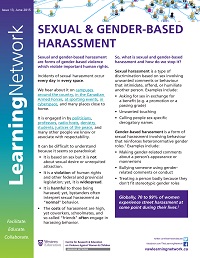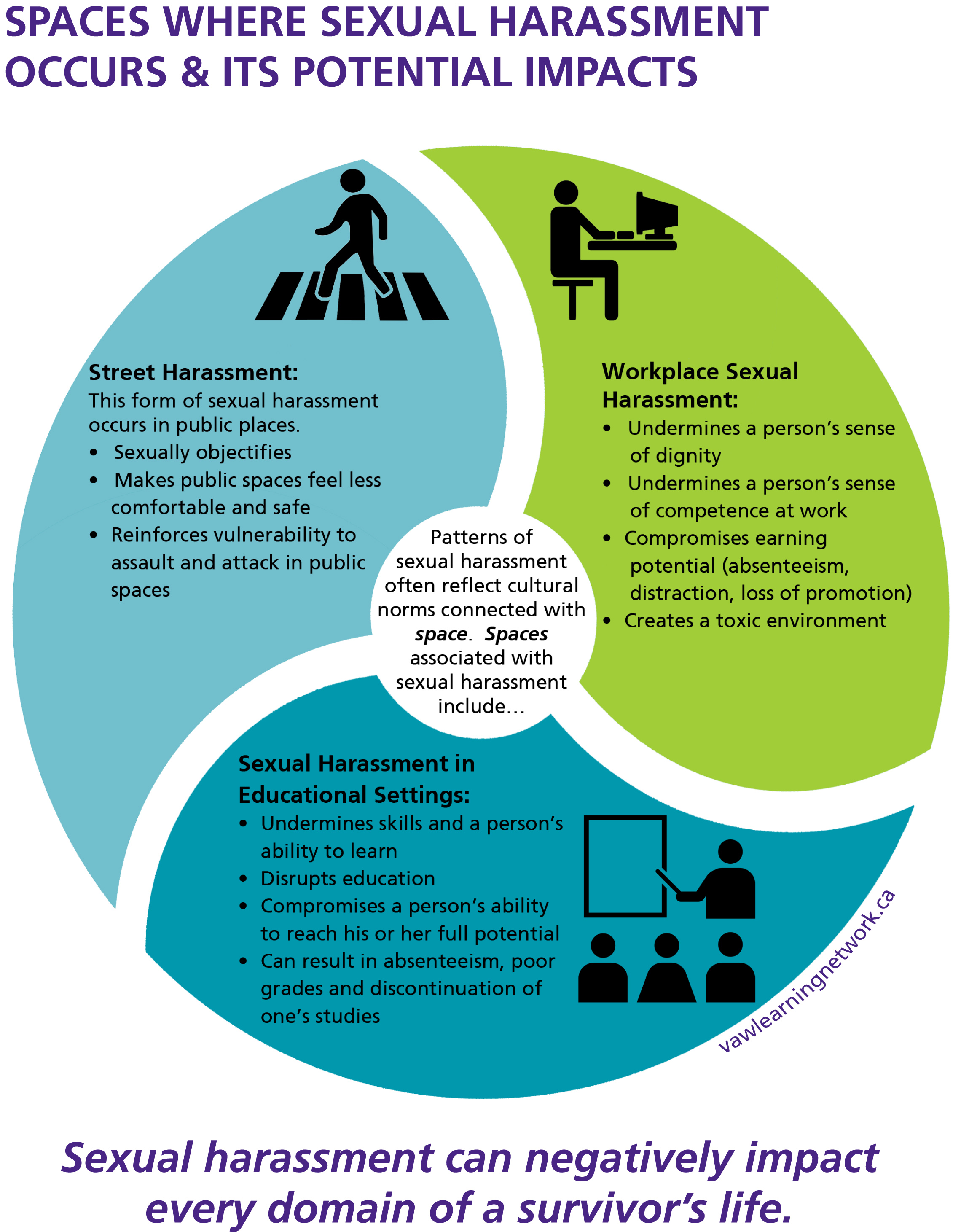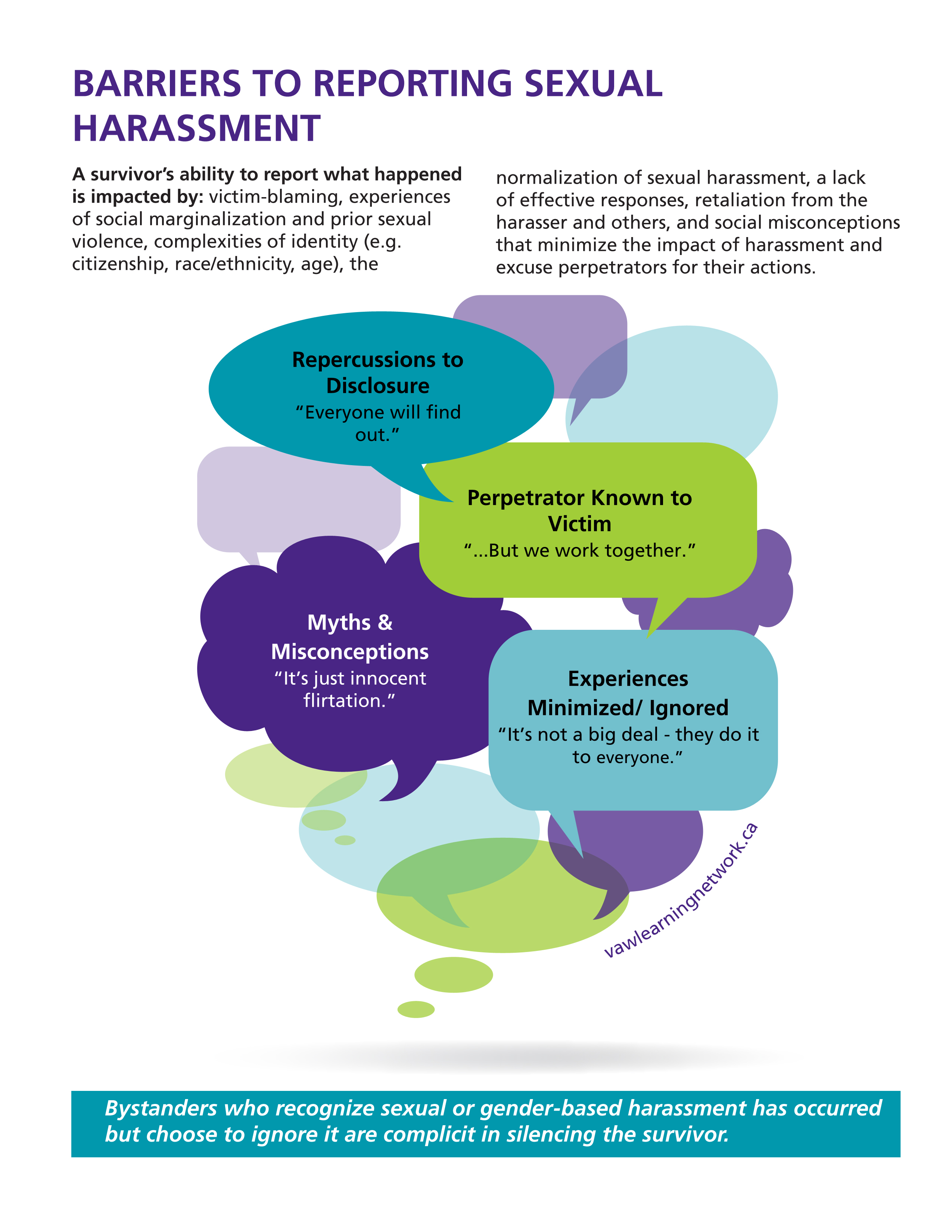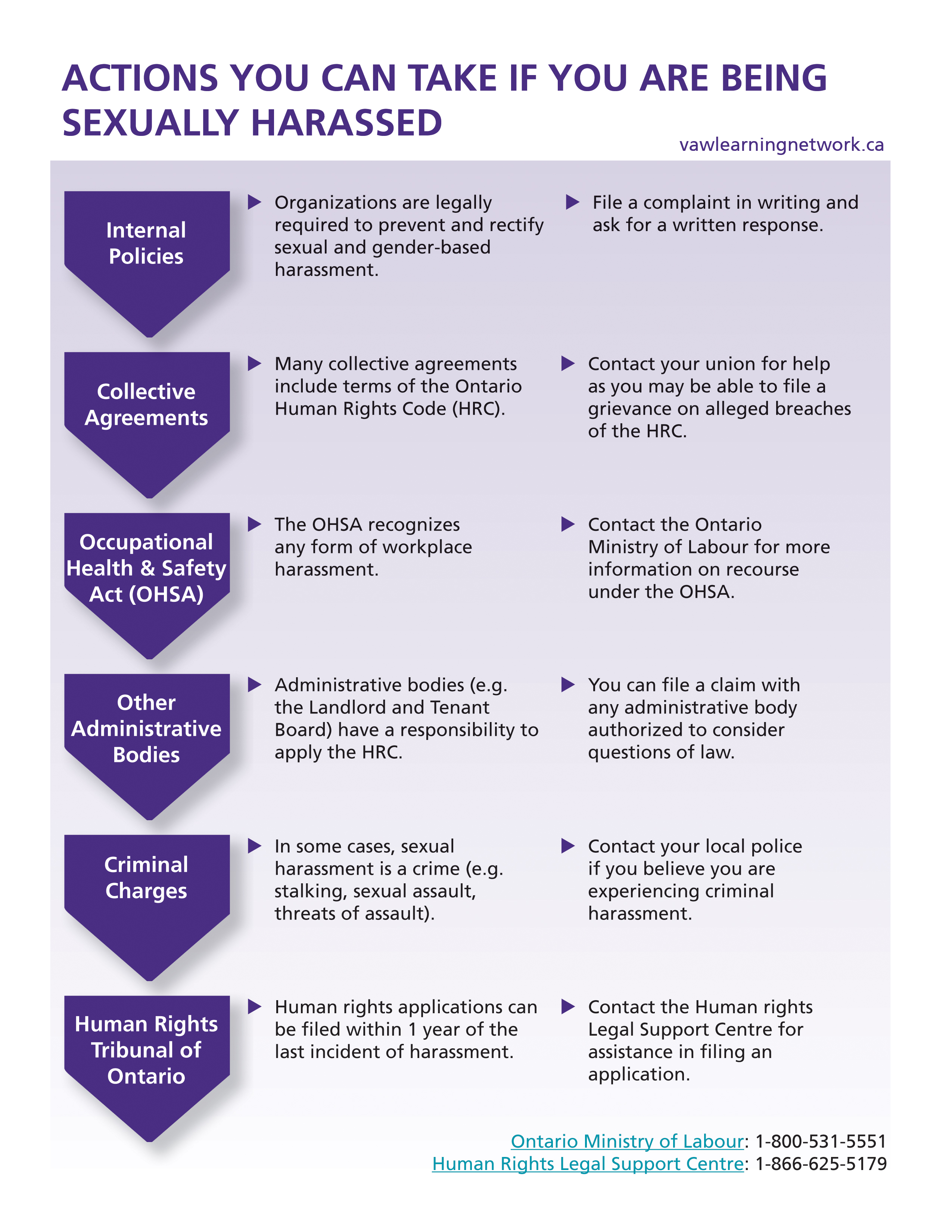Issue 13: Sexual and Gender-based Harassment
 Printable PDF Version
Printable PDF Version
PlainText Version
Sexual and gender-based harassment are forms of gender-based violence which violate important human rights.
Incidents of sexual harassment occur every day in every space.
We hear about it on campuses around the country, in the Canadian Armed Forces, at sporting events, in cyberspace, and many places close to home.
It is engaged in by politicians, professors, radio hosts, dentistry students, justices of the peace, and many other people we know or associate with respectability.
It can be difficult to understand because it seems so paradoxical:
- It is based on sex but it is not about sexual desire or unrequited attraction.
- It is a violation of human rights and other federal and provincial legislation; yet, it is widespread.
- It is harmful to those being harassed; yet, bystanders often interpret sexual harassment as “normal” behavior.
- The costs of harassment are high, yet coworkers, schoolmates, and so-called “friends” often engage in harassing behavior.
So, what is sexual and gender-based harassment and how do we stop it?
Sexual harassment is a type of discrimination based on sex involving unwanted comments or behaviour that intimidate, offend, or humiliate another person. Examples include:
- Asking for sex in exchange for a benefit (e.g. a promotion or a passing grade)
- Unwanted touching
- Calling people sex-specific derogatory names
Gender-based harassment is a form of sexual harassment involving behaviour that reinforces heteronormative gender roles.1 Examples include:
- Making gender-related comments about a person’s appearance or mannerisms
- Bullying someone using gender-related comments or conduct
- Treating a person badly because they don’t fit stereotypic gender roles
Globally, 70 to 99% of women experience street harassment at some point during their lives.2

Sexual Harassment - What is a myth & what is reality?
Myths3 |
Realities |
|---|---|
Sexual harassment is no big deal
|
It is a violation of human rights.
It is a violation of various federal, provincial/territorial and/or municipal legislations. |
|
It is a “deviant” or rare event
|
Sexual harassment is a widespread problem.
Anyone can be sexually harassed; however, subordinated groups (e.g. women, LGBTQ people, people with disabilities) are targeted more often. Street harassment can be sexist, racist, transphobic, homophobic, ableist, sizeist and/or classist. |
|
It is “normal” behaviour between sexes
|
It is not part of courtship; nor about unrequited love or romantic attraction.
It is often used to express power over another person. It is discrimination. |
|
He didn’t mean to do it
|
Sexual harassment is intentional behaviour.
Often, it re-asserts gender, race, age or class hierarchies within environments (school, work, street) in harmful ways. |
|
Stopping/reporting sexual harassment is easy
|
There are many barriers to reporting that silence women or lead them to minimize, ignore or “put up” with harassment.
Sometimes reporting creates additional problems for victims: e.g. s/he may be ostracized by co-workers, not believed, or pay for being a “whistle-blower”. |
|
“Reactions” to sexual harassment are the real problem
|
Sexual harassment causes negative consequences (e.g. poor health, loss of earning potential).
Its repercussions should never be blamed on the person being harassed. |
|
She asked for it
|
Everyone has the right to learn, work and be in settings free from discrimination. |

Resources
Hollaback!
An online network of groups across the globe that uses the internet to connect activists and those who resist street harassment. It publicly displays street harassment stories, news, photos and videos.
#WhoWillYouHelp
A Public Service announcement by the government of Ontario launched by Premier Kathleen Wynne on March 6, 2015 depicts scenes of sexual violence or harassment in the workplace, a bar, at school, and at a party with the message “when you see something, do something.”
Draw the Line
‘Draw The Line’ is an interactive campaign that aims to engage Ontarians in a dialogue about sexual violence. The campaign challenges common myths about sexual violence and harassment and equips bystanders with information on how to intervene safely and effectively.
Climb the Hill
A video produced by the Ontario Federation of Labor regarding sexual harassment in the workplace. Women with lived experience share their stories of harassment in the workplace, the impact on them and their responses.
Strategies to reduce sexual harassment in the workplace are offered.
Research
Street Harassment: Current and Promising Avenues for Researchers and Activists.
Laura Logan (2015). Sociology Compass, 9/3, 196-211.
This paper offers a concise overview of street harassment terms and definitions. It offers examples of initiatives from around the world to address this global social problem. Research on this topic has been limited, and this paper identifies areas for further research including investigating street harassment with an intersectional lens and evaluating the impact of various education and response initiatives.
Sexual Harassment Mythology: Definition, Conceptualization, and Measurement.
Kimberly A. Lonsway & Lilia M. Cortina & Vicki J. Magley (2008). Sex Roles, 58, 599-615.
The Illinois Sexual Harassment Myth Acceptance Scale is a 20 item scale which examines attitudes and beliefs that are generally false but are widely and persistently held. These myths serve to deny and justify male sexual harassment of women. This scale has since been adapted for Spanish and German cultures. The scale may be used to assess impact of myth acceptance on gender or to inform bystander intervention approaches.
Sexual & Gender-based harassment is not inevitable: Know what you can do!
3 ways to strengthen prevention and response to sexual harassment
| Recognize and address the role of your work place/school/neighborhood culture. |
|
| Pledge to be a better bystander and help others to be better bystanders. |
Learn how to safely intervene when you witness harassment:
|
| Evaluate the effectiveness of your workplace/school/other policy on sexual harassment. |
|
Things you can do if you are being sexually harassed4:
- Trust your instincts
- Know your rights and the law
- Know and seek out support
- Where it is safe to do so, tell the harasser that you want their behavior to stop.
- Take care of yourself
Things you can do that support you in Making a Report5:
Keep a written record of events, including:- What happened and who said/did it
- When and where it happened
- Witnesses to the incident
- Your response at the time – your reactions/feelings as well as attempts to tell the harasser to stop can be important if you decide to bring forth a claim
Consider taking one or more of the following options below.
Upcoming Learning Network Webinar
Drawing the Line on Workplace Sexual Harassment
September 24, 2015 | 10:00am - 11:00am EST
In this webinar, sexual violence survivor advocates Julie Lalonde and Nicole Pietsch will discuss several topics including:
- Seeing beyond the individual incident or harasser
- Taking leadership
- Drawing The Line on Sexual Harassment
Nicole Pietsch, B.A., Coordinator, Ontario Coalition of Rape Crisis Centres
Julie Lalonde, M.A., Project Manager Draw-the-line.ca Campaign
New Learning Network Resources
Learning Network Brief 26: Barriers to Reporting Sexual Harassment
This Brief discusses some of the barriers that make reporting sexual harassment difficult and for some, lead to more complex consequences.
Learning Network Brief 27: Sexual Harassment and Public Space
This Brief explores how patterns of sexual harassment often reflect the cultural norms connected with the spaces or environments (school, work, public spaces) in which it occurs. The analysis provides examples of how sexual harassment can work to define or re-assert gender, race, age or class hierarchies within spaces in harmful ways.
Guest Editor and Author
Nicole Pietsch, Coordinator, Ontario Coalition of Rape Crisis Centres
Written by the Learning Network Team
Linda Baker, Learning Director
Nicole Etherington, Research Associate
Anna-Lee Straatman, Research Associate
Elsa Barreto, Graphic Design
PLEASE EVALUATE US!
Let us know what you think. Your input is important to us. Please complete this brief survey on your thoughts of this newsletter: https://uwo.eu.qualtrics.com/jfe/form/SV_3qp8ixEOK0y2fOd
FOOTNOTES
1Government of Ontario. 2015. It’s Never Okay: An Action Plan to Stop Sexual Violence and Harassment. Toronto: Queen’s Printer for Ontario.
2Hollaback: You Have the Power to End Street Harassment. Research. www.ihollaback.org/research/
3Myths adapted from Lonsway, Cortina & Magley (2008). Sexual harassment mythology: Definition, conceptualization, and measurement. Sex Roles, 58, 599-615.
4See www.ihollaback.org for more information on ending street harassment.
5Adapted from: Ontario Human Rights Commission (2013). Policy on preventing sexual and gender-based harassment. Toronto: Queen’s Printer for Ontario.
FOLLOW US:
twitter.com/learntoendabuse
facebook.com/TheLearningNetwork
vawlearningnetwork.ca
Contact vawln@uwo.ca to join our email list!






